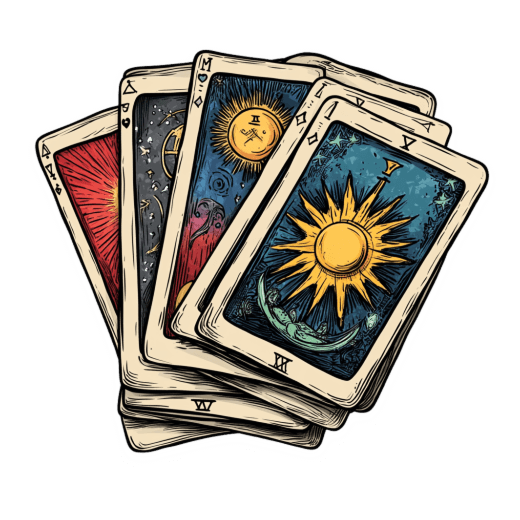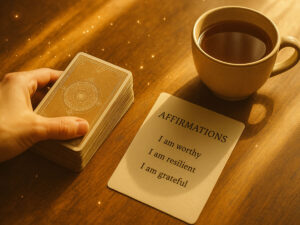Tarot Prompts for Your Daily Spiritual Journal


Table of Contents
Have you ever pulled a tarot card and felt that immediate spark of recognition, only to forget the insight days later? I certainly have! Back in the early 1990s, I experienced what I now call my “tarot amnesia phase” – pulling profound cards that offered exactly what I needed, then watching those revelations slip away like water through my fingers.
That all changed when I started keeping a tarot journal. What began as simple notes about card meanings evolved into a transformative practice that has deepened my connection with the cards in ways I never imagined possible. According to a 2024 survey by the International Tarot Foundation, practitioners who maintain regular tarot journals report 78% greater confidence in their readings and interpretation abilities!
Whether you’re new to tarot or have been reading cards for decades, journaling creates a sacred space where your intuition can flourish. As renowned tarot author Mary Greer notes, “The simple act of writing about your tarot experiences transforms passive observation into active participation with the archetypes.” I’ve found this to be profoundly true in my own practice.
In this comprehensive guide, I’ll share my favorite tarot journal prompts that span everything from daily reflections to deep shadow work. You’ll discover structured approaches that illuminate patterns in your readings, techniques for tracking your intuitive development, and prompts that help you apply tarot wisdom to real-life situations.
These prompts aren’t just about recording card meanings – they’re gateways to self-discovery. Some will challenge you, others will comfort you, but each one offers an opportunity to deepen your relationship with tarot’s ancient wisdom. I’ve organized them to support beginners while still offering depth for experienced readers.
So grab your favorite journal (I prefer unlined pages for the freedom to sketch symbols and connections), find a quiet space, and let’s explore how these 55 tarot journal prompts can transform your practice in 2025. The cards have been waiting to tell you their stories – it’s time to write them down.
Unlocking Your Intuition: Essential Tarot Journaling Basics
I still remember my first “real” tarot journal – a simple black notebook with gold-edged pages that I found at a garage sale for 50 cents. Nothing fancy, but something about it felt right. Twenty-five years later, I’ve filled dozens of journals, each one a time capsule of my spiritual journey.
The beauty of tarot journaling lies in its simplicity. At its core, it’s simply the practice of recording your card draws, interpretations, and reflections. But don’t be fooled by this simplicity – consistent journaling creates a powerful feedback loop that enhances your intuitive abilities in remarkable ways.
When I first started teaching tarot workshops in 1998, I noticed something interesting: students who kept journals progressed twice as quickly as those who didn’t. There’s something almost magical about the act of writing that helps cement your understanding of the cards’ language. As tarot historian Robert Place explains, “Writing activates different neural pathways than reading or thinking alone, creating deeper memory imprints.”
Your journal doesn’t need to follow any prescribed format. Some practitioners prefer highly structured entries with dedicated spaces for card positions, intuitive hits, and follow-up reflections. Others (like myself) enjoy a more free-flowing approach where drawings, quotes, and personal insights mingle together. There’s no wrong way to journal – the only mistake is not starting at all!
I recommend beginning with a simple daily card pull. Each morning, draw a single card, record it in your journal, and write your initial impressions. Keep it brief – even just 3-5 sentences is enough. Then, in the evening, revisit your journal and reflect on how the card’s energy manifested throughout your day. This simple practice builds a foundation of personal meanings that go beyond any book interpretation.
For those who prefer more structure, try the “RISE” method I developed with my advanced students:
- Record: Note the card(s) pulled and date/time
- Interpret: Write your immediate impressions
- Symbolize: Identify 3 symbols that stand out and explore their meaning
- Experience: Connect the reading to your life experience
The most important aspect of tarot journaling isn’t perfection – it’s presence. Some days your entries will flow with profound insights; other days might feel mechanical. Both are valuable parts of the process. As one of my students (now a professional reader herself) put it, “My tarot journal saw me at my best and worst, and never judged either.”
Morning Reflection Prompts: Start Your Day with Tarot Wisdom
My morning tarot ritual has become as essential as that first cup of coffee. In fact, I often joke with my students that I don’t fully wake up until I’ve pulled my daily card! This practice grounds me in possibility rather than obligation – a subtle but powerful shift in how I approach each day.
Morning is an especially potent time for tarot work. The veil between conscious and unconscious mind is still thin, making it easier to access intuitive insights. I’ve found that morning reflections set a contemplative tone that carries throughout the day, creating space for synchronicities to emerge.
Try starting with this simple prompt: “What energy should I be aware of today?” Draw one card, and spend 5-10 minutes journaling about how you might harness or navigate this energy. For example, if you pull the High Priestess, you might focus on trusting your intuition during an important meeting, or creating space for silence amidst a busy schedule.
When I pulled the Five of Pentacles before an important interview back in 2007, my first reaction was dismay. But journaling about it helped me recognize that I needed to address my feelings of “not being enough” before walking into that room. I acknowledged my impostor syndrome fears, created affirmations to counter them, and ended up giving one of my strongest interviews ever. The card wasn’t predicting failure – it was highlighting what needed attention.
For more structured morning reflection, try these prompts with your daily card:
- How might this card’s energy influence my interactions today?
- What opportunity does this card suggest I remain open to?
- If this card represents a challenge, what resources can I draw upon?
- What one action would align me with this card’s highest potential?
- How does this card connect to my current goals or projects?
I’ve discovered that the real power comes from revisiting these morning reflections at day’s end. The completed circle creates a powerful learning opportunity. In my journal, I leave space below each morning entry to add evening observations about how the card’s energy manifested. Sometimes the connections are obvious; other times they’re subtle or surprising.
One student shared that she pulled the Fool before a routine workday, wondering how such adventurous energy could possibly manifest in her structured office environment. That afternoon, she was unexpectedly offered a position on a new project that would require learning entirely new skills. Had she not been primed by her morning reflection, she might have declined out of fear rather than recognizing the growth opportunity.
Remember that consistency matters more than perfection. Even on hectic mornings, a three-sentence reflection is better than nothing. As you build this practice, you’re not just learning about tarot – you’re developing a personalized language of symbols that speaks directly to your life experience.
Shadow Work Prompts: Illuminating Your Hidden Self Through Tarot
I’ll never forget my first intentional shadow work session with tarot. Sitting at my kitchen table at 2 AM, hands trembling slightly, I asked the cards to show me what I was avoiding. The Tower appeared, and I nearly put the deck away right then! Twenty years later, I consider that moment a turning point in both my tarot practice and personal growth journey.
Shadow work, the process of examining the parts of ourselves we’ve denied, repressed, or disowned, can be intimidating. Yet the tarot offers a uniquely gentle pathway into these hidden aspects of self. As Jungian analyst James Hollis writes, “When we approach the shadow through symbolism rather than direct confrontation, we create a safe container for transformation.”
The cards that most people dread (Death, The Tower, The Devil, the 10 of Swords) become powerful allies in shadow work. They speak truth without judgment, showing us not just what needs attention, but also the potential gifts waiting on the other side of our resistance.
When journaling for shadow work, create a supportive environment first. I light a candle, keep grounding stones nearby, and set a clear boundary around my practice time. I also write a self-compassion statement at the top of my journal page: “I approach this exploration with curiosity rather than judgment.”
Try these shadow work prompts, allowing your intuition to guide which one feels most appropriate:
- Draw a card representing something I’m currently avoiding or denying.
- What fear has been controlling my decisions lately? (Pull one card for the fear, another for how to address it)
- Draw a card showing a quality I dislike in others but may possess myself.
- What outdated belief is ready to be released? (Pull cards for the belief, its origin, and what might replace it)
- How am I sabotaging my own happiness? (Use a three-card spread: the pattern, its root cause, and how to transform it)
In my workshops, I’ve noticed that people often expect shadow work to be uniformly heavy or painful. While it certainly can touch tender places, it frequently brings unexpected relief and even humor. One participant burst out laughing when she pulled the 7 of Cups for “something I’m currently avoiding.” She’d been procrastinating on making a decision by endlessly researching options!
I encourage a practice of “bookending” shadow work journaling. Begin with a grounding exercise, and end by recording at least three insights or points of gratitude that emerged from the session. This creates emotional safety and helps integrate the experience.
Remember that shadow work isn’t about fixing what’s “wrong” with you. It’s about reclaiming the energy that’s been tied up in denial and resistance. Some of my most profound tarot moments have come through this work, revealing that what I feared most often contained exactly what I needed for wholeness.
The first time I used the “quality I dislike in others” prompt, I pulled the Queen of Swords. Initially confused, I journaled about the qualities I associated with this card: critical judgment, emotional detachment, and intellectual superiority. With growing discomfort, I recognized these traits in myself, particularly in professional settings where I felt insecure. This revelation allowed me to transform criticism into discernment and detachment into healthy boundaries.
Shadow work journaling benefits from consistency but requires sensitivity to your emotional state. I advise my students to schedule regular sessions while remaining flexible. Some days you might be ready for deep diving; other days might call for gentler exploration. Trust your intuition about what feels appropriate, and remember that small, consistent steps often yield more lasting transformation than occasional intense sessions.
For beginners, I suggest starting with the “Draw a card for what needs attention right now” prompt weekly for a month. This gradual approach builds comfort with shadow elements while developing your unique relationship with the cards as psychological tools. Your journal becomes a safe container for this exploration, holding insights that often reveal their full significance only with time and reflection.
Relationship Clarity: Tarot Prompts for Understanding Connections
Relationships have always been the number one topic in my professional readings, whether romantic partnerships, family dynamics, friendships, or work connections. Our interactions with others form the tapestry of our lives, yet they often contain patterns we can’t see when we’re enmeshed in them. This is where tarot journaling becomes particularly illuminating.
I learned this lesson personally in 2001 when journaling with the 6 of Cups repeatedly appeared in readings about my marriage. Initially, I focused only on the card’s sweeter aspects: nostalgia, innocence, kindness. But continued journaling revealed a more complex truth: I was relating to my partner through the lens of our shared past rather than our evolving present. This insight, though challenging, ultimately helped us build a more authentic connection.
When journaling about relationships, specificity matters. Rather than asking general questions like “How is my relationship?” try targeted prompts that illuminate particular aspects of the connection. This creates clarity rather than confusion.
For romantic relationships, these prompts can be especially revealing:
- What is the current energy between myself and [person]? (Follow with: How is this serving or limiting our growth?)
- Draw three cards: How they see me, how I see them, the unseen potential between us.
- What lesson is this relationship bringing into my life right now?
- What am I not seeing clearly about our dynamic? (This one requires brutal honesty in your journaling!)
- If our relationship were a story, what would be the next chapter? (Pull cards for key themes and potential developments)
Friendship journaling has helped me navigate complex transitions, like when a close friend moved across the country. Using the prompt “How can I best support this friendship through change?” gave me practical insights that helped maintain our connection despite the distance.
Family relationships, often the most complex, benefit from prompts that acknowledge both challenge and possibility:
- What inherited pattern am I perpetuating in this relationship?
- Draw cards for: the surface relationship, the underlying dynamic, and potential for healing.
- What boundary needs strengthening in this relationship?
I’ve found that relationship journaling works best when approached with genuine curiosity rather than an agenda. When I’m hoping for specific cards to appear, I’m usually trying to validate what I want to be true rather than seeing what is true. The most valuable insights often come when I’m willing to be surprised or even disappointed by what the cards reveal.
One practical tip: When journaling about challenging relationships, try writing in the third person for part of your entry. This creates helpful emotional distance and can reveal patterns that might be obscured when you’re writing from within the emotional field of the relationship.
Remember that the cards themselves have complex relationships with each other in your spreads. Notice which ones appear together frequently in your relationship readings. These combinations often speak to core themes in how you connect with others.
I once worked with a client who kept a dedicated “relationship journal” for six months during a difficult separation. She used a simple weekly spread: one card for “what I need to understand about myself,” one for “what I need to understand about my partner,” and one for “what needs attention now.” The journal became a safe container for processing complex emotions and ultimately helped her make clear decisions based on insight rather than reactivity.
For those in new relationships, I recommend the “relationship potential” spread: cards representing the relationship’s foundation, current energy, potential growth areas, and wisdom needed. Journaling with this spread creates a thoughtful assessment without falling into fantasy or premature commitment.
Work relationships also benefit from tarot journaling, particularly when navigating difficult dynamics with colleagues or supervisors. The prompt “What unconscious patterns am I bringing to this professional relationship?” often reveals surprising insights about how past experiences influence current workplace interactions.
Whatever relationship you’re exploring, remember to journal both the challenging and positive aspects revealed by the cards. Our connections contain multitudes, and acknowledging their complexity leads to more authentic understanding and growth.
Career and Purpose Prompts: Navigating Your Path with Tarot
My first career-focused tarot journal entry, dated September 1995, contains a simple three-card spread and the question: “Should I quit my corporate job?” Looking back at those yellowed pages, I’m struck by how clearly the cards pointed to my future path as a tarot professional, though at the time, I completely misinterpreted them! I saw the Eight of Pentacles as suggesting I needed to “work harder” at my existing job, missing its message about developing craftsmanship in a new field entirely.
This early misreading taught me something valuable: career journaling with tarot reveals its wisdom over time. What seems like confusing or contradictory guidance often makes perfect sense in retrospect. This is why consistent documentation is so crucial. It creates a map of your evolving relationship with work and purpose.
Career journaling isn’t just for those considering dramatic changes. It’s equally valuable for deepening satisfaction in your current role, identifying growth opportunities, or clarifying your authentic contribution. I’ve worked with executives who use tarot journaling to develop leadership qualities and entrepreneurs who consult their journals before making business decisions.
These prompts can illuminate various aspects of your professional journey:
- What unrecognized skill or talent am I ready to develop further?
- Draw cards for: my current career situation, unseen opportunities, and potential obstacles.
- How does my work align (or not align) with my core values?
- What aspect of my professional life needs more attention right now?
- If my career were a hero’s journey, what stage am I currently in?
Purpose-related journaling often benefits from a wider lens than just paid work. Some of my most fulfilling purpose work happens in volunteer roles and personal projects. Try these broader prompts:
- How am I being called to contribute to others at this time in my life?
- What brings me authentic joy, and how might I incorporate more of it?
- Draw cards representing: my current purpose, my evolving purpose, and the bridge between them.
In 2012, I developed what I now call the “Career Compass Spread” for my journal: four cards placed in the cardinal directions, representing different aspects of professional fulfillment. North shows your ultimate aspiration, East reveals emerging opportunities, South grounds you in practical considerations, and West highlights what must be released or completed. Journaling with this spread quarterly provides remarkable clarity about career evolution.
I’ve noticed that certain cards frequently appear in career readings for those on the verge of meaningful transitions. The Fool often heralds new beginnings that require a leap of faith. The Death card, though intimidating, typically signals necessary endings that create space for rebirth. The Hanged Man commonly appears when a shift in perspective is needed before action can be taken.
When journaling about work challenges, try this technique: write about the situation in detail, then pull three cards. Rather than immediately interpreting them, step away for at least an hour. When you return, the emotional intensity has often subsided enough to see creative solutions that weren’t visible before.
Remember that career journaling benefits enormously from tracking patterns over time. Note which cards appear repeatedly in your professional readings, as they often highlight themes in your work life that need attention or development.
One client, a frustrated middle manager, kept seeing the Knight of Wands in career readings. Initially, she interpreted this as a call to be more aggressive in pursuing promotion. After three months of journaling, she realized the card was actually highlighting her entrepreneurial spirit and desire for more autonomy. This insight eventually led her to launch a successful consulting business where she could utilize her corporate experience while enjoying greater freedom.
Career transition periods particularly benefit from consistent tarot journaling. During my own shift from corporate work to professional tarot reading, I created a monthly check-in spread: cards for lessons learned, current challenges, unexpected opportunities, and next steps. This structured approach helped me navigate the uncertainty of career change with greater confidence and clarity.
For those feeling stuck or unfulfilled in their work, I recommend the “passion project prompt”: Pull a card representing an activity that would bring you joy, regardless of its practical application. Journal about this activity without censoring yourself with concerns about practicality. Often, these explorations reveal dormant talents or interests that can eventually transform your career path in surprising ways.
Seasonal and Lunar Cycle Prompts: Aligning with Natural Rhythms
The first time I aligned my tarot practice with the lunar cycle was during a particularly difficult winter in 2005. Feeling disconnected and spiritually depleted, I committed to journaling with the moon phases as my guide. By spring, not only had my tarot practice deepened significantly, but I’d developed an entirely new relationship with time itself.
Nature’s cycles offer a profound framework for tarot journaling, creating a rhythm that connects personal insight with universal patterns. As author and witch Judika Illes notes, “When we align our spiritual practices with natural cycles, we tap into currents of energy that have sustained humanity throughout history.”
The lunar cycle provides an accessible monthly structure for tarot work. I’ve found that different phases naturally support different types of journaling:
- New Moon: Ideal for intention-setting and beginning new projects. Try this prompt: “What seed of possibility is ready to be planted in my life?” Journal with cards that represent potential new beginnings.
- Waxing Moon: Perfect for tracking progress and gathering momentum. Prompt: “What actions will help manifest my new moon intentions?” Pull cards for guidance on building energy toward your goals.
- Full Moon: A time for culmination and clear seeing. This prompt is powerful: “What is being illuminated in my life that was previously hidden?” The cards often reveal surprising insights at this peak energy.
- Waning Moon: Supports release work and completion. Prompt: “What am I ready to release that no longer serves me?” Journal about cards that appear, focusing on healthy letting go.
During my 2005 experiment, I was astonished by how certain cards consistently appeared at specific moon phases. The High Priestess frequently emerged during new moons, while the Moon card itself often appeared at the full moon, creating a sense of meaningful synchronicity.
Seasonal journaling creates a larger container for exploring life transitions. Each solstice and equinox offers a natural pause point for deeper reflection:
- Spring Equinox: “What is awakening in me now?” Journal about cards representing new growth and emerging potential.
- Summer Solstice: “What is reaching its fullest expression in my life?” Explore cards showing abundance and peak energy.
- Autumn Equinox: “What harvest am I gathering, and what must I release?” Journal about the balance of gain and loss.
- Winter Solstice: “What wisdom awaits in the darkness?” Work with cards that represent introspection and inner knowing.
I’ve maintained seasonal journals for over fifteen years now, and they’ve become treasured time capsules of my spiritual journey. Revisiting winter solstice entries from years past shows clear evolutionary threads in my relationship with introspection and shadow work.
One practical technique I’ve developed is creating “seasonal spreads” in my journal. I draw a central card representing the essence of the coming season, surrounded by cards for practical guidance, spiritual focus, relationships, and creative expression during this time. Journaling with this spread at each seasonal turning point provides a comprehensive map for navigating the months ahead.
Remember that working with natural cycles isn’t about rigid adherence to dates on a calendar—it’s about developing sensitivity to the energy shifts happening both around and within you. Some of my most meaningful seasonal journaling has happened several days before or after the “official” turning points, when I personally felt the energy shift.
Tarot Journal Templates: Creating Structure for Deeper Insights
My first tarot journal was a chaotic jumble of interpretations, questions, and random observations. It was effective for capturing insights, but nearly impossible to reference later. It wasn’t until 2009, when a student showed me her beautifully organized journal system, that I realized how much depth I was missing through disorganization.
Creating intentional structure in your tarot journal dramatically enhances its value over time. Templates provide consistent frameworks that make it easier to track patterns, deepen interpretations, and witness your evolving relationship with the cards. As tarot author Barbara Moore suggests, “Structure in journaling doesn’t limit creativity; it creates a container that allows insights to crystallize.”
The simplest effective template includes these elements:
- Date, time, and any significant circumstances (moon phase, personal context, etc.)
- Question or intention for the reading
- Cards drawn and their positions
- Initial intuitive impressions (before consulting books)
- Deeper reflections and connections to your situation
- Follow-up observations (added later as insights manifest)
For visual learners, I recommend creating diagram templates that allow you to sketch the cards in position. I’ve found that drawing even simple representations of the cards activates different cognitive pathways than writing alone. One of my students, an architect, created a brilliant template with transparent overlays that allow her to track how card relationships evolve in subsequent readings.
Digital journaling offers powerful organizational advantages. Apps like Notion, Evernote, or specialized tarot journaling platforms allow you to tag entries, search for specific cards or themes, and create connections between related readings. I resisted digital journaling for years (I love the tactile experience of pen on paper), but now maintain a hybrid system. I use handwritten entries for daily draws and digital formats for more complex spreads I want to track over time.
For those who enjoy the bullet journal approach, try these specialized tarot trackers:
- Card encounter logs: Simple grids where you mark each time you draw a specific card, creating a visual representation of which archetypes appear most frequently in your life
- Reading reflection matrices: Tables that track how accurately readings reflected eventual outcomes
- Intuition development trackers: Spaces to record initial impressions alongside what actually manifested, helping you identify your strongest intuitive channels
I’ve developed a particularly effective spread-mapping technique I call “connection journaling.” After recording a spread, I draw lines between cards that seem to speak to each other, creating a visual web of relationships. Then I journal about these connections specifically, often discovering meanings I missed when considering each card in isolation.
Color-coding adds another dimension to your journal. I use different colors to distinguish between initial impressions, book meanings, personal associations, and follow-up observations. This creates a visual map of how my understanding evolved and where insights originated.
Remember that your journal system should serve you, not become another obligation. Start with simple structures and allow them to evolve organically as you discover what works best for your learning style and tarot practice. The perfect journal template is the one you’ll actually use consistently.
Many practitioners find it helpful to include dedicated sections in their journals for different types of readings. A client of mine divides her journal into sections for daily draws, monthly forecasts, question-specific readings, and dream interpretations. This organization makes it easy to track how certain themes develop across different contexts.
Templates can also help deepen your relationship with specific cards. Consider creating dedicated pages for cards that frequently appear in your readings or ones you’re studying intensively. Include traditional meanings, personal associations, memories of when the card appeared in significant readings, and even sketches of symbols that stand out to you.
For those who appreciate technological solutions, spreadsheet templates offer powerful analytical capabilities. One advanced student created a spreadsheet that tracks card frequency, combinations, and correlations with life events over time. This approach revealed fascinating patterns, such as the tendency for certain cards to appear during specific seasons or life transitions.
Whatever templates you choose, remember to leave room for the unexpected. Some of my most profound tarot insights emerged from breaking my own structures and following intuitive nudges to journal in new ways. The best templates create a balance between consistent documentation and creative exploration.
Start Your Tarot Journaling Practice Today
When I look back at my collection of tarot journals spanning nearly three decades, I don’t just see records of card pulls and interpretations—I see the story of my life, reflected through the profound mirror of the tarot. Each journal entry marks a conversation between my conscious mind and deeper wisdom, creating a documented journey of growth that continues to inform my practice today.
The prompts and techniques shared in this guide aren’t just abstract suggestions—they’re pathways I’ve personally walked and shared with hundreds of students over the years. I’ve witnessed how consistent tarot journaling transforms hesitant beginners into confident readers, and helps experienced practitioners break through plateaus to discover entirely new depths in their practice.
As tarot continues to experience a remarkable renaissance in 2025, journaling offers an antidote to the sometimes superficial “Instagram interpretation” approach that reduces these complex archetypes to simplified catchphrases. Your journal creates space for nuance, contradiction, and personal meaning—elements that form the heart of authentic tarot practice.
The most powerful aspect of tarot journaling isn’t perfection but presence. Some days your entries will flow with profound insights; other days might feel mechanical or uninspired. Both are valuable parts of the process. As one of my teachers once told me, “The cards speak in whispers as often as they shout.”
I encourage you to begin wherever you are. If you’re new to tarot, start with simple daily card pulls and brief reflections. If you’re an experienced reader, challenge yourself with shadow work prompts or create more complex journaling systems to track patterns over time. The journey unfolds differently for each person, but the rewards of consistent practice are universal.
Remember that your tarot journal is a living document—one that evolves as you do. Let it be messy, contradictory, and real. Let it capture your questions as well as your insights, your confusion alongside your clarity. In embracing this wholeness, your journal becomes not just a record of readings, but a sacred text uniquely your own.
I’d love to hear how these prompts and techniques work for you. Connect with me through my website or at the workshops I’ll be conducting throughout 2025. Your journaling journey is just beginning, and the cards have so much more to show you.
Frequently Asked Questions
Do I need a special type of journal for tarot journaling?
Not at all! While beautiful journals can inspire practice, what matters most is functionality. In my early years, I used simple composition notebooks. Consider what works best for your style—unlined pages allow for drawing and free-form expression, while structured journals with prompts provide helpful guidance for beginners. Some practitioners prefer digital journaling for searchability. I recommend choosing something that feels inviting enough that you’ll actually use it consistently.
How often should I write in my tarot journal?
Consistency matters more than frequency. I’ve found that daily journaling with a single card creates the strongest foundation, but even weekly sessions yield significant benefits. One approach that works well for busy periods is what I call “anchor journaling”—committed sessions on the new and full moons, with briefer entries as time allows between these points. Remember that a 5-minute entry is infinitely more valuable than no entry at all.
What if I don’t understand the card I’ve pulled?
This is actually a perfect journaling opportunity! Begin by writing about your confusion itself—what feels unclear and why? Record your intuitive impressions before consulting references, noting symbols that stand out. After researching traditional meanings, journal about the gap between your initial impression and standard interpretations. Some of my most profound insights have emerged from initially confusing draws, as they often point to blind spots or areas where I’m developing new understanding.
Should I record spreads that don’t seem accurate or relevant?
Absolutely yes! These entries often become the most valuable over time. In 2013, I pulled what seemed like a completely irrelevant spread about relationship changes when my partnership felt stable. Three months later, we faced unexpected challenges that perfectly reflected the cards. Journaling about “misses” helps you develop discernment and often reveals that the timing of the insight was simply different than expected.
How do I track patterns in my readings over time?
Try creating an index page in your journal where you note recurring cards, combinations, or themes. Some practitioners dedicate pages to each major arcana card, adding dates and brief notes whenever it appears. Digital journaling makes this easier through tagging systems. I maintain a simple spreadsheet tracking which cards appear most frequently by month and season, which has revealed fascinating patterns over years of practice.
What if I’m concerned about privacy in my tarot journal?
Your journal is personal space—create whatever boundaries help you feel safe expressing honestly. Some practitioners use code words for sensitive topics or people. Others maintain separate journals for different areas of exploration. If privacy is a significant concern, digital journals with password protection offer security. Remember that self-censorship diminishes the value of journaling, so find approaches that allow authentic expression while respecting your privacy needs.
Can tarot journaling replace professional readings?
They serve different purposes. Journaling develops your personal relationship with the cards and tracks insights over time, while professional readings offer fresh perspective and objective insights. I’ve maintained my journaling practice throughout my career as both reader and client. The most powerful approach combines both—journaling before a professional reading helps clarify your questions, while journaling afterward helps integrate the insights received.






